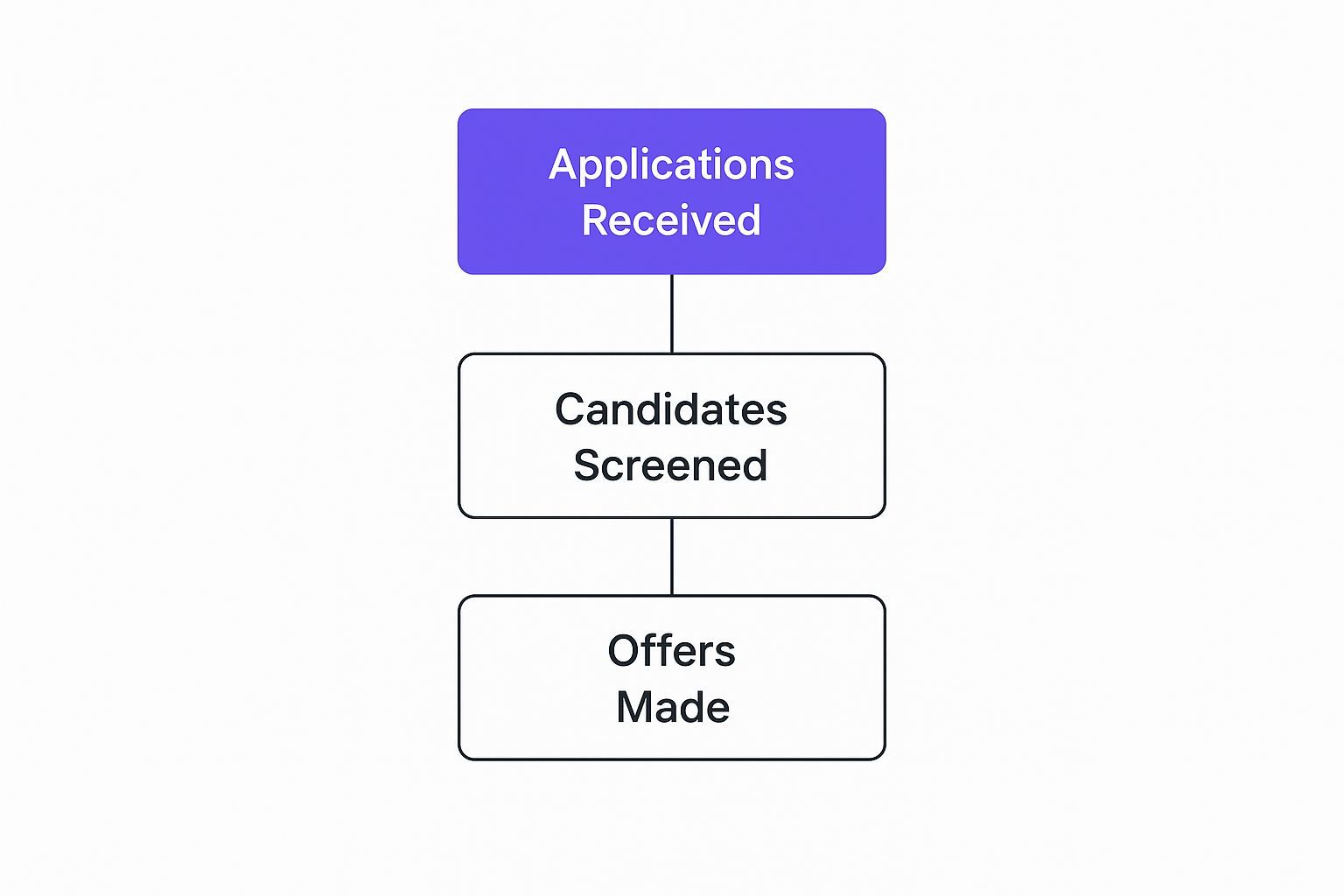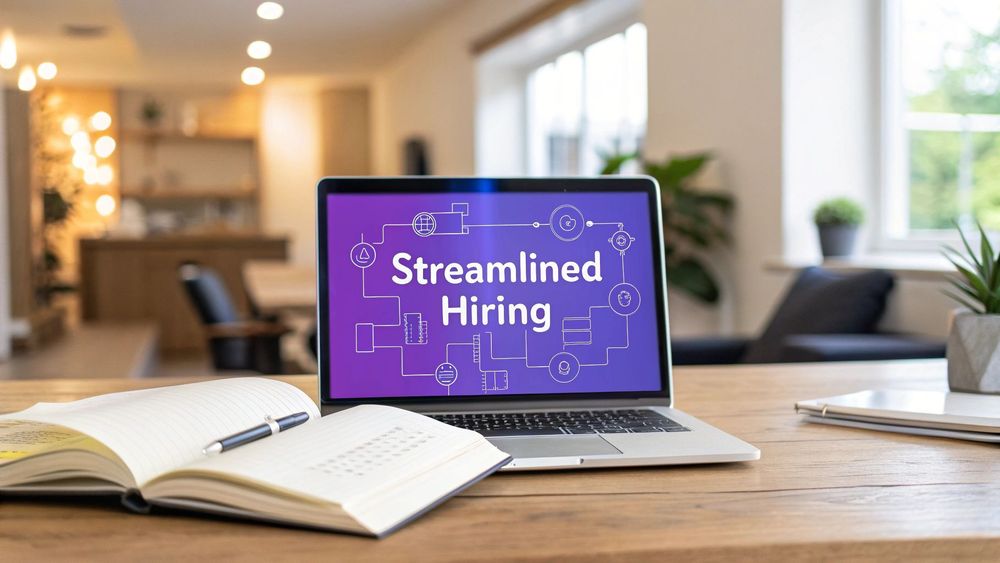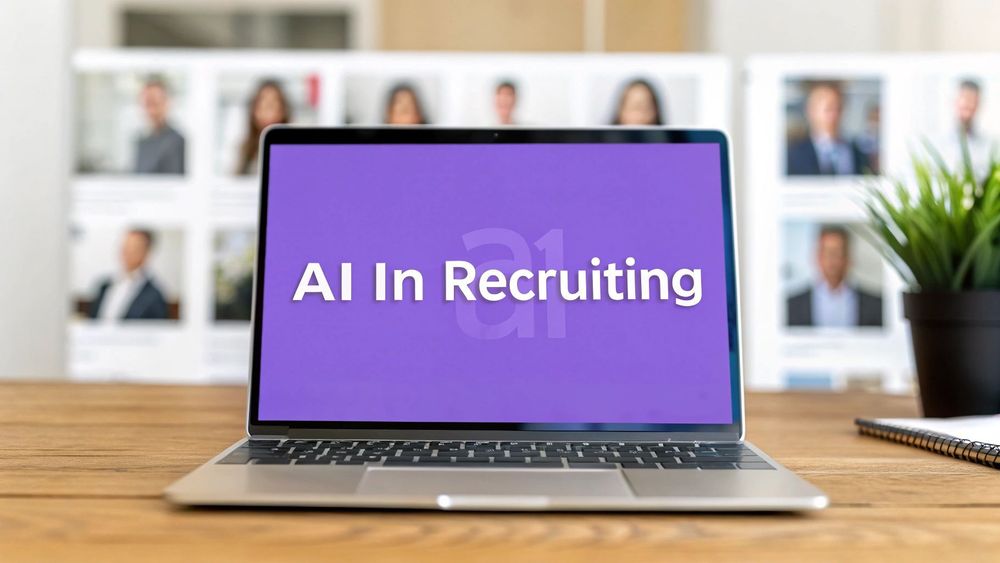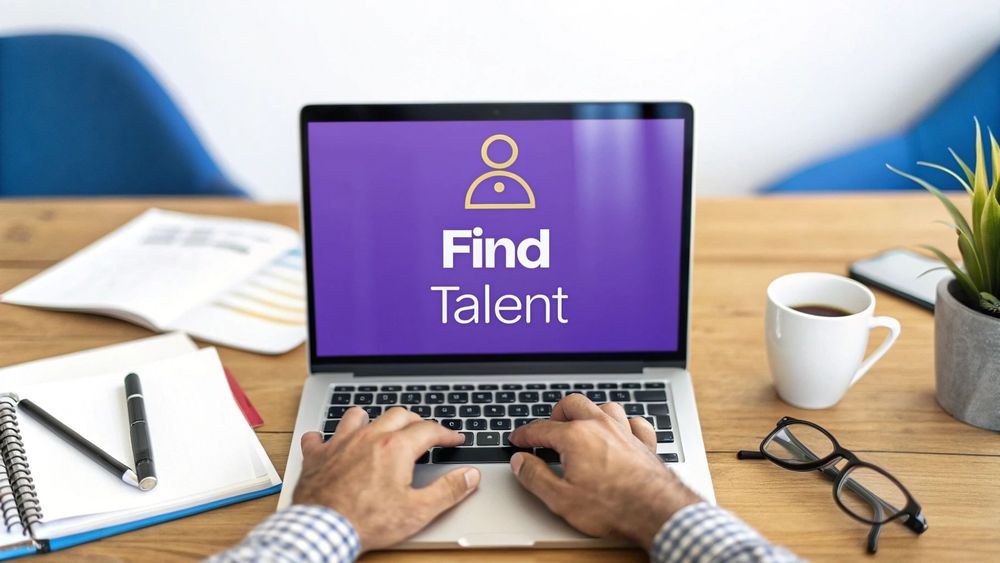Improving your recruiting process isn't just about minor tweaks here and there. It’s a systematic overhaul of your entire hiring workflow—making it faster, more effective, and a genuinely better experience for everyone involved. We’re talking about a strategic look at everything from sourcing and screening to interviewing and onboarding, all to win and keep top talent in a ridiculously competitive market.
Why Recruiting Process Improvement Matters Now

In today's talent market, a slow, clunky hiring process has gone from being an internal headache to a major business risk. Outdated workflows don't just delay hires; they actively push away the exact people you need to grow your company. This is why improving your recruiting process is no longer just a nice-to-have HR project—it's a strategic must-do.
The real problem for most companies is a process filled with invisible friction. These hidden bottlenecks cause you to lose great candidates, burn out your recruiters, and can even do a number on your company's brand. When a fantastic applicant is left waiting weeks for feedback or gets dragged through a messy interview loop, they don't just drop out. They often tell their friends and post about it online, poisoning the well for future talent.
The True Cost of an Inefficient Process
A sloppy recruiting workflow has real costs, both direct and indirect, that ripple across the entire organization. Understanding these is the first step in making the case for a change.
Here's what you're really up against:
- Lost Talent: The best candidates are often off the market in just 10 days. If your process drags, you're consistently losing out to competitors who can move faster.
- Wasted Resources: Think about the hours your recruiters sink into manual, repetitive tasks—endless data entry, scheduling nightmares, and sifting through piles of resumes. That’s time they could be spending building relationships with high-value candidates.
- Damaged Employer Brand: A bad candidate experience is a huge turnoff. In fact, over 75% of candidates who have a negative experience will share it, either online or with their network.
- Lower Quality of Hire: When you’re scrambling to fill a role, you make rushed decisions. This often leads to hiring someone who isn't the right fit, which just kicks off the expensive hiring cycle all over again.
A great hiring process is a competitive advantage. It signals to the market that your company is organized, respectful of people's time, and a desirable place to work. Neglecting it is like running a sales team with a broken CRM—you're guaranteed to miss opportunities.
Pillars of a Successful Transformation
To get this right, you need a structured approach. Instead of trying to boil the ocean, focus on three foundational pillars that will guide your efforts and create real, lasting change.
First, you have to diagnose the core issues. This means mapping out your current workflow from the moment a job is opened to when an offer is accepted. You need to find exactly where the delays and frustrations are happening. Second, it’s about adopting smart technology to automate the grunt work and give you better data to make decisions. Finally, and most importantly, you must prioritize the candidate journey, making sure every single touchpoint is positive, professional, and engaging.
Focusing on these key areas provides a clear path to transforming your recruiting efforts.
Key Areas for Immediate Recruiting Process Improvement
The table below breaks down the foundational pillars into actionable objectives and the metrics you'll use to measure success.
| Pillar | Objective | Primary Metric |
|---|---|---|
| Diagnose Core Issues | Identify and eliminate bottlenecks in the hiring funnel. | Time-to-Hire |
| Adopt Smart Technology | Automate manual tasks to free up recruiter time. | Recruiter Productivity/Activity |
| Prioritize Candidate Journey | Improve the applicant experience from start to finish. | Candidate Satisfaction (CSAT) Score |
By addressing each of these pillars, you can turn your recruiting function from a reactive cost center into a proactive, strategic asset for growth. This guide will walk you through exactly how to do it.
How to Diagnose Your Current Recruiting Bottlenecks

If you want to make any real improvements to your recruiting process, you have to start by figuring out where things are actually breaking down. Guessing where the problem is will just lead to wasted time and effort on "solutions" that don't fix the root cause. This isn't about pointing fingers; it's about getting a clear picture so you can build a faster, smarter hiring machine.
The first, non-negotiable step is process mapping. This is just a fancy way of saying you need to draw out your entire hiring workflow, from the moment a manager says "I need to hire someone" to the day a new hire accepts their offer. Think of it as creating a blueprint for your recruiting assembly line.
You need to map out every single action, every decision, and every time work gets handed off to someone else. By laying it all out visually, you turn a vague, abstract process into a concrete chart where the bottlenecks practically jump off the page.
Uncovering Common Bottlenecks
With your process map in hand, you can start hunting for the usual suspects. In my experience, most of the delays and frustrations in recruiting tend to cluster around a few key areas. These friction points don't just slow you down—they're often the very reason your best candidates drop out and take another offer.
Here are some of the most common bottlenecks I see:
- Delayed Application Reviews: Resumes just sit in the Applicant Tracking System (ATS), sometimes for days, sometimes for weeks. Top talent applies to multiple jobs at once, and they simply won't wait around.
- Chaotic Interview Scheduling: That endless email chain trying to sync up schedules between the candidate, the recruiter, and three different interviewers? It's a momentum killer.
- Poor Recruiter-Manager Communication: When recruiters and hiring managers aren't perfectly aligned on what a "great" candidate looks like, you end up sourcing the wrong people. This leads to wasted interviews and a lot of frustration for everyone.
A bottleneck is any stage in your process where work piles up faster than it can be handled. Nailing down these choke points is the single most important step you can take toward a more efficient hiring process.
Figuring out what's slowing down your hiring is crucial, but it's also helpful to see how these ideas fit into the bigger picture of team efficiency. Many of the same principles apply. For a broader look at diagnosing problems and boosting output on any team, check out these strategies for improving team productivity.
Blending Data with Human Feedback
A truly great diagnosis isn't just about the numbers or just about feelings—it's about both. You need the hard data to see what's happening and the human feedback to understand why it's happening.
Quantitative Data (The 'What')
Your ATS is a goldmine of objective data just waiting to be analyzed. Start by pulling reports that show you exactly where things are getting stuck.
- Time-in-Stage: How long are candidates sitting in each phase of the process (Application Review, Phone Screen, Final Interview, etc.)? If one stage is taking way longer than the others, you've found a bottleneck.
- Candidate Drop-Off Rates: At which stage are you losing the most candidates? A huge drop-off rate right after the first interview, for example, might signal a problem with the interview experience itself.
- Source-to-Hire Time: How long does it take to hire someone from a specific source, like LinkedIn versus a job board? This can show you where your sourcing efforts are—or aren't—paying off.
Qualitative Feedback (The 'Why')
Numbers tell a story, but they don't always give you the full plot. To get the 'why' behind the 'what', you have to actually talk to the people involved.
- Candidate Surveys: Send out short, anonymous surveys to everyone who applies, even the ones you reject. Ask them about their experience, how clear the communication was, and what they thought of the interview process.
- Hiring Manager Interviews: Grab coffee with your hiring managers and just listen. Where are they getting frustrated? What parts of the process feel slow or clunky to them?
- Recruiter Debriefs: Your own team is on the front lines every day. Hold regular meetings to talk candidly about what's working, what's a total pain, and where they think improvements can be made.
Don't forget, recruiting doesn't happen in a vacuum. Recent data shows that 77% of organizations are struggling to fill roles. They're running into major roadblocks like not getting enough applicants (60%) and candidates ghosting them (46%). Knowing about these market-wide pressures helps put your own internal challenges into perspective.
When you bring together the hard data and honest human feedback, you stop feeling overwhelmed and start seeing a clear, actionable path forward.
Adopting a Framework for Your Improvement Strategy
Alright, you've pinpointed the bottlenecks slowing down your hiring. Now what? The temptation is to jump in and start fixing things reactively, but that often leads to a messy, disorganized effort with shaky results.
This is where a formal improvement framework comes in. Think of it as the blueprint for your renovation project. You wouldn't start knocking down walls without a plan, right? The same logic applies here. A framework gives you a clear, step-by-step method to make changes that actually stick.
Your process diagnosis was like a doctor identifying an illness. The framework is the prescribed treatment plan that leads to a full recovery. Without it, you’re just treating symptoms, and the root causes will keep flaring up.

Every handoff in this funnel is a place where things can go wrong—or a place where a smart framework can make things go incredibly right.
Choosing the Right Framework
There's no one-size-fits-all solution here. The best framework for your team will depend on your specific problems, your company culture, and how fast you need to fill roles. Let's look at three popular methodologies and see how they apply to the real world of recruiting.
1. Lean Recruiting: Eliminating Waste
The core idea of Lean, which comes from the world of manufacturing, is simple: systematically cut out any step that doesn't add real value. In recruiting, "waste" is everywhere—from too many interview rounds to hours spent on manual data entry or redundant paperwork.
- How It Works: You map out your entire process and ask a brutally honest question at each step: "Does this activity directly help us find and hire the best person?" If the answer is no, you get rid of it or simplify it.
- Recruiting Example: A team realized their seven-stage interview process for a junior role was overkill. Using Lean, they identified two redundant stages and combined them. The result? They cut their interview timeline by a full week and saw candidate drop-off decrease by 25%.
2. Agile for Recruiting: Speed and Adaptability
Borrowed from software development, Agile is built for fast-paced environments where hiring needs shift on a dime. It’s all about breaking big goals into small, manageable "sprints"—short, focused periods of intense work.
- How It Works: Instead of trying to fill 20 roles at once, you might launch a two-week sprint focused only on hiring three critical sales reps. The team huddles daily, adjusts its strategy based on what's working, and pours all its energy into that one goal.
- Recruiting Example: A tech company needed a team of five engineers for a new project—fast. They created an Agile "squad" with a recruiter, a hiring manager, and a technical interviewer. By dedicating two weeks to nothing but that search, they sourced, interviewed, and sent out offers, filling all the roles before the project deadline.
A framework transforms your improvement efforts from a collection of well-intentioned guesses into a repeatable, data-driven system. It provides the structure needed to ensure every change you make is a step in the right direction.
3. DMAIC: The Data-Driven Overhaul
For those deep-rooted, complex problems that just won't go away, the DMAIC (Define, Measure, Analyze, Improve, Control) framework offers a powerful, data-first approach. It’s more intense than Lean or Agile and is perfect for a complete process overhaul.
- Define: State the problem with painful clarity. (e.g., "Our time-to-hire for engineers is 90 days, which is double the industry average.")
- Measure: Gather the data to prove how bad the problem really is.
- Analyze: Dig into that data to find the root causes of the delays.
- Improve: Design and test solutions that directly attack those root causes.
- Control: Lock in your gains. Put new systems in place to make sure you don't slide back into old habits.
By picking one of these frameworks, you give your recruiting process improvement strategy the structure it needs to be organized, targeted, and ultimately, a game-changer for your team.
Using Technology to Build a Smarter Hiring Process

Technology is the engine of any modern recruiting operation. Honestly, moving beyond manual methods isn't just a nice-to-have anymore; it's the only way to keep up. A good tech stack doesn't just make you faster—it helps you build a more intelligent, data-driven, and genuinely effective hiring function.
The goal isn't to just pile up software subscriptions. It's about creating a connected ecosystem where tools talk to each other. This system should handle the low-value, repetitive tasks, give you clear insights into what's working, and free up your team to do what people do best: build real relationships with great candidates.
The Central Hub: Your Applicant Tracking System
Think of your Applicant Tracking System (ATS) as the command center for your entire recruiting operation. If you're just using it as a digital filing cabinet for resumes, you're leaving most of its power on the table. A well-used ATS automates communication, tracks candidates through every single stage, and gives you the hard data needed to spot where things are slowing down.
It’s the central nervous system connecting every part of the hiring body. It makes sure information flows from sourcers to hiring managers without falling into the black holes where so many good candidates tend to disappear.
Automating the Top of the Funnel
Let’s be real: the most time-consuming part of recruiting is often right at the beginning—finding and sifting through candidates. This is where manual work can bring your entire process to a screeching halt. Thankfully, this is exactly what intelligent automation tools were built to solve.
- AI-Powered Sourcing: These tools can scan millions of profiles across the web to find people who fit your specific criteria, often uncovering passive talent you would have completely missed otherwise.
- Automated Screening: Instead of a human reading through hundreds of nearly identical resumes, AI can quickly parse applications to flag the most qualified people based on actual skills and experience.
- Scheduling Automation: The endless email chain of trying to schedule an interview is a notorious time-sink. Scheduling tools plug right into everyone's calendars, find a time that works, and send the invites and reminders for you.
The rise of AI hiring and intelligent assessment tools is completely changing the game, giving us powerful new ways to improve how we hire.
Solving the Sourcing Bottleneck with One-Click Extraction
One of the biggest time drains for any recruiter is pure, mind-numbing data entry. Finding a fantastic candidate on LinkedIn is one thing, but manually getting their information into your system is another. It’s a painful process of copy-pasting names, job titles, companies, and contact details—which is both incredibly slow and full of typos.
This is where a no-code scraping tool becomes a recruiter's secret weapon.
The old-school way of manually building a talent pipeline is fundamentally broken. It’s slow, inefficient, and simply doesn’t scale. Modern recruiters need tools that replace clicks with intelligence.
This is the exact challenge ProfileSpider was created to solve. Instead of wasting hours on data entry, a recruiter can go to any website with professional profiles—LinkedIn, a company's 'About Us' page, an industry directory—and pull complete, structured data with a single click.
This isn't just a minor tweak; it's a fundamental shift in the sourcing workflow.
- Before ProfileSpider: A recruiter might burn 20-30 minutes just to manually build out detailed profiles for a handful of candidates.
- With ProfileSpider: That same recruiter can build a rich, targeted list of 50+ candidates in the same amount of time, complete with contact info and social links.
This kind of tool directly attacks the sourcing bottleneck, turning a manual chore into an efficient, automated part of the process. With its AI-powered engine, ProfileSpider ensures accurate extraction of names, job titles, companies, and more, saving hours of manual research. By using a modern profile scraper, recruiters can put their energy where it matters: outreach and engagement, not data entry.
The numbers back this up. For instance, companies using AI for candidate assessments report a 46% faster hiring cycle. On top of that, 85% of HR professionals believe data analytics will be essential for refining their recruitment strategies in the near future. These stats show that bringing smart tools into your workflow is a key driver of recruiting process improvement. When you automate the top-of-funnel activities, you don't just hire faster—you build a more strategic and effective talent team.
Designing a Candidate Experience That Wins Top Talent
In the race for top talent, a clunky, impersonal hiring process is a guaranteed way to finish last. The best candidates have options, and their journey—from the first click on your job ad to the final offer letter—shapes their entire perception of your company.
Improving the candidate experience isn't just a "nice-to-have" HR metric; it's a core competitive advantage that directly impacts who you can hire. It’s about creating a series of positive, respectful, and transparent interactions at every single touchpoint. A great experience builds your employer brand, while a poor one can tarnish your reputation and actively shrink your talent pool.
Writing Job Descriptions That Attract and Include
The whole journey starts with your job description. This is often the first real conversation a potential hire has with your company, and it needs to do more than just rattle off a list of responsibilities. It needs to sell the opportunity and show that you've built an inclusive culture.
Vague, jargon-filled posts are a huge turn-off for qualified people. Instead, focus on clarity and use language that actually connects with the person you want to hire.
- Focus on Impact: Don't just list tasks. Describe the impact the role will have on the team and the company's big-picture goals. What problems will they solve?
- Use Inclusive Language: Ditch the corporate buzzwords and gendered terms that can subtly alienate entire segments of the talent pool.
- Be Transparent: Put the salary range right in the description. Be crystal clear about key responsibilities and required qualifications to set the right expectations from day one.
Maintaining Communication and Transparency
Silence is the number one reason candidates ghost you. Leaving applicants in the dark creates anxiety and screams disorganization. A huge part of any recruiting process improvement strategy is simply establishing a clear and consistent communication rhythm.
Even a simple automated email confirming you got their application is a good start. From there, send updates at each stage—even if it's just a quick note to say a decision is still a week away. This small effort shows you respect their time and keeps them from wondering if their application fell into a black hole.
A great candidate experience is built on a foundation of respect. Every interaction, from an automated email to a final interview, is an opportunity to show candidates that you value their time and interest.
This commitment to communication is a cornerstone of modern talent acquisition. To deal with today's hiring pressures, 40% of talent acquisition leaders now prioritize building stronger candidate relationships, and 39% are focused on improving communication to stop people from dropping out.
Structuring Seamless and Respectful Interviews
The interview is the heart of the candidate experience. This is your chance to see if they have the skills, but it's also their chance to decide if they actually want to work with you. A chaotic, unprepared, or disrespectful interview process is a massive red flag for top performers.
Make sure every single interviewer is trained and aligned on what the role requires. Give them the candidate's resume and a clear set of questions to ask. This simple step prevents the frustrating experience where a candidate has to repeat the same stories in every single meeting.
Providing Meaningful Feedback
Want to do something that almost no one else does? Provide feedback to candidates you don't end up hiring. While it might not be practical for every single applicant at the top of the funnel, offering brief, constructive feedback to those who made it to the final rounds leaves a lasting positive impression.
This simple act of professional courtesy can turn a rejected candidate into a future applicant, a customer, or even a source for referrals. They'll remember that your company treated them like a human being. This approach is central to building a long-term talent pipeline and connects directly to a broader talent attraction strategy. You can see how this all fits together by understanding what recruitment marketing is and how it shapes perceptions long before a job is even posted.
How to Measure Success and Drive Continuous Improvement
A great recruiting process is never really finished. Think of it less like a project with an end date and more like a living system—one that needs to be measured, tweaked, and adapted over time. Without a clear way to track what’s working (and what isn’t), any changes you make are just shots in the dark.
The right data is what turns your recruiting function from a reactive, problem-solving machine into a proactive, strategic powerhouse. This is where you build a sustainable cycle of improvement by monitoring the right numbers, understanding the stories they tell, and building a team culture that’s always looking for the next small win.
Essential KPIs for Every Recruiting Team
So, how do you know if your changes are actually moving the needle? You track a handful of core metrics. These KPIs give you an objective, no-fluff view of your hiring engine's health. While you could track dozens of things, these four give you the most bang for your buck.
Time-to-Hire: This is the big one. It tracks the total number of days from when a job is officially opened to when your chosen candidate signs on the dotted line. A long time-to-hire is often a flashing red light for bottlenecks in sourcing, interviewing, or decision-making. And it’s critical for staying competitive—top candidates are often off the market in just 10 days.
Cost-per-Hire: Pretty straightforward. This adds up all the costs associated with a single hire, from recruiter salaries and ad spend to your tech stack. Keeping an eye on this number helps you understand the financial efficiency of your process and makes it much easier to justify investing in new tools that actually deliver.
Quality-of-Hire: This is the holy grail of recruiting metrics. It’s also the toughest to nail down. Quality-of-hire looks at the long-term value a new employee brings, usually measured through things like their first-year performance reviews, retention rates, and feedback from their hiring manager. At the end of the day, high-quality hires are the entire point.
Candidate Satisfaction (cNPS): Ever wonder what candidates really think of your process? The Candidate Net Promoter Score tells you. It’s usually a simple survey asking applicants how likely they are to recommend applying to your company. A low score is a huge red flag for a poor candidate experience, which can quietly poison your employer brand and shrink your talent pool.
From Data Tracking to Actionable Insights
Just collecting numbers is pointless. The real magic happens when you start interpreting the data to spot trends and figure out what to fix next. Your KPIs should be conversation starters, not just numbers on a dashboard.
For instance, if your time-to-hire is dragging but your quality-of-hire is fantastic, maybe your process is slow but incredibly effective. On the flip side, if you're hiring lightning-fast but people are leaving within six months, you’re probably moving too quickly and cutting corners.
Data tells you where to look, not what to do. The goal is to use metrics to ask better questions: Why are we losing so many people at the final interview? Which sourcing channel is actually bringing in our best performers?
Fostering a Culture of Continuous Improvement
The final piece of the puzzle isn't a metric—it's your team's mindset. A truly great recruiting function is one where everyone feels empowered to adapt and evolve the process. This means creating an environment where performance is reviewed openly (and without blame), new ideas get tested, and you let the data guide your next move.
Here’s what that looks like in practice:
- Regular KPI Reviews: Get the team together monthly or quarterly to look at the numbers and brainstorm solutions.
- Pilot Programs: Want to try a new tool or interview format? Test it on a small scale first before you roll it out to the whole company.
- Feedback Loops: Actively ask hiring managers and new hires about their experience. Their insights are gold.
By making measurement and review a natural rhythm for your team, you shift recruiting from a series of disconnected tasks into a strategic asset that’s always getting better.
Common Questions About Fixing Your Recruiting Process
When you start digging into how to improve your recruiting workflow, a few practical questions always seem to pop up. Let's tackle the most common ones teams run into when they're trying to put these ideas into practice.
Where Do I Even Start With Improving Our Recruiting Process?
The absolute best place to start is by mapping out your current process. Seriously. Before you touch a single thing, you need a crystal-clear visual of every single step, from the moment a job gets approved all the way to a new hire's first day.
This kind of audit forces you to pinpoint your real bottlenecks and sticking points with actual evidence, not just hunches. Make sure you pull in recruiters, hiring managers, and even a few recent hires to get the full, unvarnished picture of how things really work.
How Can a Small Business Improve Recruiting Without a Big Budget?
For smaller teams, it's all about high-impact, low-cost moves. The easiest win? Communication. Set clear expectations and give timely updates to every single candidate. It costs nothing but builds a massive amount of goodwill.
Next, get your interview process standardized. This ensures every candidate gets a fair shot and makes your team way more efficient.
A fantastic, budget-friendly hack is to get smarter with your sourcing tools. Instead of burning hours on manual data entry, a no-code scraping tool like ProfileSpider can build you targeted candidate lists from social platforms in a fraction of the time. That one change can free up dozens of hours for the work that actually matters.
And don't forget the classics—a simple employee referral program is still one of the most powerful and cost-effective ways to find amazing talent.
How Do I Get Hiring Managers on Board With Process Changes?
Getting buy-in from hiring managers is all about framing the changes in a way that speaks directly to them and their teams. Use the data from your process map to show them exactly how the current system is causing delays or costing them great candidates for their open roles.
You have to position your ideas as solutions that will help them hire better people, faster. But the real key? Involve them in redesigning the process. When hiring managers have a hand in shaping the new workflow, they become champions for its success.




